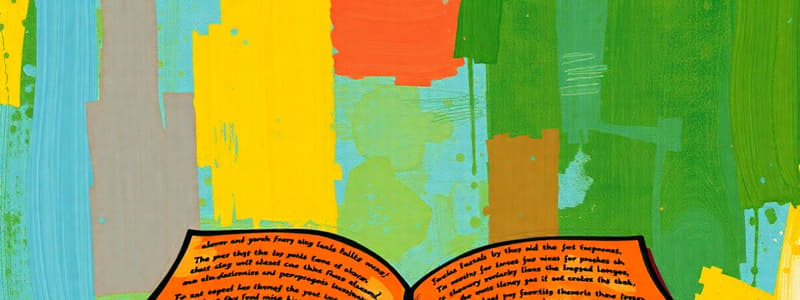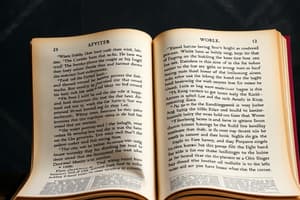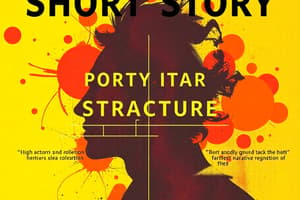Podcast
Questions and Answers
What is the central topic of a story known as?
What is the central topic of a story known as?
- Plot
- Theme (correct)
- Character
- Setting
Characters in a story can only be human beings.
Characters in a story can only be human beings.
False (B)
Name the two types of characters based on development.
Name the two types of characters based on development.
Flat and round
The central topic of a story is referred to as its _______.
The central topic of a story is referred to as its _______.
Match the following terms to their definitions:
Match the following terms to their definitions:
Which pronouns are commonly used in the first person point of view?
Which pronouns are commonly used in the first person point of view?
The third person omniscient point of view allows the reader to gain insight into just one character's thoughts and experiences.
The third person omniscient point of view allows the reader to gain insight into just one character's thoughts and experiences.
What is the term for the underlying message or idea in a story?
What is the term for the underlying message or idea in a story?
In the second person point of view, the author uses the pronouns ______.
In the second person point of view, the author uses the pronouns ______.
Match the following points of view with their description:
Match the following points of view with their description:
Flashcards
Point of View (POV)
Point of View (POV)
The perspective from which a story is told. It's how the author presents the experiences and thoughts of characters.
Second Person POV
Second Person POV
The author speaks directly to the reader as if they are experiencing the story. Pronouns like 'you' and 'your' are used.
Third Person Limited POV
Third Person Limited POV
The author focuses on one character's thoughts and experiences, limiting the reader's perspective to just that character.
Third Person Omniscient POV
Third Person Omniscient POV
Signup and view all the flashcards
Theme
Theme
Signup and view all the flashcards
Characters
Characters
Signup and view all the flashcards
Protagonist
Protagonist
Signup and view all the flashcards
Antagonist
Antagonist
Signup and view all the flashcards
Flat Characters
Flat Characters
Signup and view all the flashcards
Study Notes
Elements of a Story
- Setting - The time and place in which the story takes place or develops. It is more formally considered the plot or length of the beginning to end.
- Plot - The plot traces the parts of the story from beginning to the next to overcome conflict or a problem within the story. The plot pattern follows the novelist Gustav Freytag who discovered common structures and patterns within short stories and plots.
- Exposition - Introduces important background information, for example, information about the setting and events occurring before the main plot, characters' back stories.
- Inciting incident - A single event that begins the action or main conflict in the story.
- Rising action - A series of related incidents that build toward the point of greatest interest. It begins immediately after the exposition (introduction) of the story and builds up to the climax.
- Climax - The highest or most intense point in the development or resolution of the conflict.
- Falling action - The events resulting from or leading from the climax.
- Resolution - The part of a story in which the main conflict is resolved .
- Denouement - The ending of the story in which the author answers all remaining questions, reveals how the characters feel about what took place, and sometimes suggests what is in store for the characters.
- Point of View - The perspective from which the author tells the story. There are three points of view:
- First person - The author tells the story from his or her vantage point. This means that events in the story unfold to the reader as the author sees them.
Studying That Suits You
Use AI to generate personalized quizzes and flashcards to suit your learning preferences.




